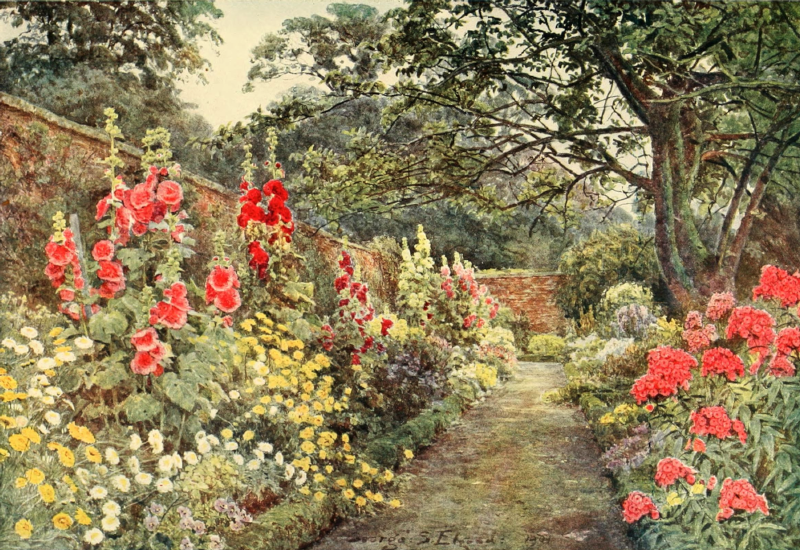| Web
and Book design,
Copyright, Kellscraft Studio 1999-2021 (Return to Web Text-ures) |
 (HOME)
|
|
HOLLYHOCKS
AT BLYBOROUGH
Here
is a large walled garden, originally all kitchen garden; the length equal to
twice the breadth, divided in the middle to form two squares. It is further
subdivided in the usual manner with walks parallel to the walls, some ten feet
away from them, and other walks across and across each square. The paths are
box-edged and bordered on each side with fine groups of hardy flowers, such as
the Hollyhocks and other flowers in the picture. The
time is August, and these grand flowers are at their fullest bloom. They are
the best type of Hollyhock too, with the wide
outer petal, and the middle of the flower not too tightly packed. Hollyhocks
have so long been favourite flowers — and, indeed, what would our late summer
and autumn gardens be  BLYBOROUGH: HOLLYHOCKS From the picture in the possession of Mr. C. E. Freeling
The
loosely-folded inner petals of the loveliest Hollyhocks invite a wonderful play
and brilliancy of colour. Some of the colour is transmitted through the
half-transparency of the petal's structure, some is reflected from the
neighbouring folds; the light striking back and forth with infinitely beautiful
trick and playful variation, so that some inner regions of the heart of a rosy
flower, obeying the mysterious agencies of sunlight, texture and local colour,
may tell upon the eye as pure scarlet; while the wide outer petal, in itself
generally rather lighter in colour, with its slightly waved surface and gently
frilled edge, plays the game of give and take with light and tint in quite
other, but always delightful, ways. Then
see how well the groups have been placed; the rosy group leading to the fuller
red, with a distant sulphur-coloured gathering at the far end; its tall spires
of bloom shooting up and telling well against the distant tree masses above the
wall. And how pleasantly the colour of the rosy group is repeated in the Phlox
in the opposite border. And what a capital group that is, near the Hollyhocks
of that fine summer flower, the double Crown Daisy (Chrysanthemum
coronarium), with the bright glimpses of some more of it beyond. Then the
Pansies and Erigerons give a mellowing of grey-lilac that helps the brighter
colours, and is not overdone. The
large fruit-tree has too spreading a shade to allow of much actual bloom
immediately beneath it, so that here is a patch of Butcher's Broom, a
shade-loving plant. Beyond, out in the sunlight again, is the fine herbaceous
Clematis (C. recta), whose excellent qualities entitle it to a much more
frequent use in gardens. The flower-borders
are so full and luxuriant that they completely hide the vegetable quarters
within, for the garden is still a kitchen garden as to its main inner spaces.
These masses of good flowers are the work of the Misses Freeling; they are
ardent gardeners, sparing themselves no labour or trouble; to their care and
fine perception of the best use of flowers the beauty and interest of these
fine borders are entirely due. Indeed, this garden is a striking instance of
the extreme value of personal effort combined with knowledge and good taste. These
qualities may operate in different gardens in a hundred varying ways, but where
they exist there will be, in some form or other, a delightful garden. Endless
are the possibilities of beautiful combinations of flowers; just as endless is
their power of giving happiness and the very purest of human delight. So also
the special interest of different gardens that are personally directed by
owners of knowledge and fine taste would seem to be endless too, for each will
impress upon it some visible issue of his own perception or discernment of
beauty. About
the house and lawns are other beds and borders of herbaceous flowers of good
grouping and fine growth; conspicuous among them is that excellent flower Campanula
pyramidalis, splendidly grown. Though Blyborough is in a cold district, it has the advantage of lying well sheltered below a sharply-rising ridge of higher land. |